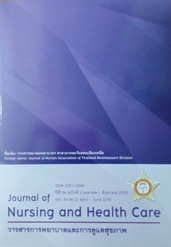การปรับเปลี่ยนพฤติกรรมสุขภาพในผู้ที่มีภาวะเมตาบอลิกซินโดรม: การวิจัยแบบมีส่วนร่วม Health Behavior Modification of the Metabolic Syndrome: Participatory Action Research
คำสำคัญ:
การปรับเปลี่ยนพฤติกรรมสุขภาพ ภาวะเมตาบอลิกซินโดรม model modifying health behaviors, metabolic syndromeบทคัดย่อ
การวิจัยครั้งนี้เป็นการวิจัยเชิงปฏิบัติการแบบมีส่วนร่วม มีวัตถุประสงค์เพื่อพัฒนารูปแบบการปรับเปลี่ยน
พฤติกรรมสุขภาพ เพื่อควบคุมภาวะเมตาบอลิกในผูที้่มีภาวะเมตาบอลิกซินโดรม มีขั้นตอนการดำเนินการวิจัยแบง่
ออกเป็น 3 ระยะ คือ ระยะที่ 1 ประเมินสถานการณ์ ระยะที่ 2 ระยะปฏิบัติการ และระยะที่ 3 การประเมินผลในระยะ
ประเมินสถานการณ์เป็นการศึกษาปัญหาภาวะเมตาบอลิกซินโดรมในชุมชนโดยการสัมภาษณ์เชิงลึกและการสนทนา
กลุ่ม ทำให้ได้เนื้อหาสำคัญของรูปแบบเหมาะแก่การควบคุมภาวะเมตาบอลิกซินโดรม ซึ่งประกอบด้วย 1) ความรู้
เฉพาะเจาะจงเกี่ยวกับภาวะเมตาบอลิกซินโดรม การออกกำลังกาย และการบริโภคอาหาร 2) การฝึกปฏิบัติทักษะ
การประเมินสุขภาพตนเองการออกกำลังกาย การบริโภคอาหาร เป็นกลุ่มและรายบุคคล 3) การประเมินผลและให้
ข้อมูลย้อนกลับติดตามเยี่ยมกระตุ้น ให้กำลังใจ แก้ไขปัญหาเกี่ยวกับการออกกำลังกายและการบริโภคอาหาร
รายบุคคล โดยผู้เชี่ยวชาญเฉพาะด้านระยะปฏิบัติการใชข้ อ้ มูลที่ไดม้ าพัฒนารูปแบบการปรับเปลี่ยนพฤติกรรมสุขภาพในผูที้่มีภาวะเมตาบอลิกซินโดรมโดยออกแบบรว่ มกันกับระหวา่ งผูวิ้จัยกับผูเ้ ขา้ รว่ มวิจัยที่เปน็ กลุม่ ทดลอง กลุม่ ตัวอยา่ งกลุม่ ทดลองและกลุม่ ควบคุมกลุม่ ละ 50 คน โดยการสุม่ ตัวอยา่ งแบบงา่ ย กลุม่ ทดลองไดรั้บรูปแบบการปรับเปลี่ยนพฤติกรรมสุขภาพ ระยะเวลา12 สัปดาห์ ส่วนกลุ่มควบคุมได้รับการให้บริการสุขภาพตามปกติ วิเคราะห์ข้อมูลโดยใช้สถิติเชิงพรรณนาได้แก่ร้อยละ ค่าเฉลี่ย ส่วนเบี่ยงเบนมาตรฐาน สถิติอนุมาน ได้แก่ Paired sample t-test, Independent t-test และ95% CI กำหนดที่ระดับนัยสำคัญทางสถิติ .05ระยะประเมินผลหลังการดำเนินกิจกรรมเป็นระยะเวลา 12 สัปดาห์ ผลการวิจัยพบว่าตัวชี้วัดของภาวะเมตาบอลิกซินโดรม หลังการทดลองกลุ่มทดลองมีความแตกต่างกับกลุ่มควบคุม ดังนี้ 1) ขนาดเส้นรอบเอว( = 83.66, SD = 6.29) น้อยกว่ากลุ่มควบคุม ( = 87.52, SD = 8.14) อย่างมีนัยสำคัญทางสถิติ (p-value < .05;95% CI: -6.75 ถึง -.97) 2) ความดันเลือดขณะบีบตัว ( = 122.16, SD = 8.77) น้อยกว่ากลุ่มควบคุม ( = 135.94,SD = 15.85) อย่างมีนัยสำคัญทางสถิติ (p-value <.05; 95% CI: -18.86 ถึง -8.69) และความดันเลือดขณะคลายตัว( = 78.60, SD = 6.63) น้อยกว่ากลุ่มควบคุม ( = 85.20, SD = 8.65) อย่างมีนัยสำคัญทางสถิติ (p-value <.05;95% CI: -9.65 ถึง -3.54) 3) นํ้าตาลในเลือด ( = 97.18, SD = 17.04) น้อยกว่ากลุ่มควบคุม ( = 112.28,SD = 18.68) อย่างมีนัยสำคัญทางสถิติ (p-value <.05; 95% CI: -22.26 ถึง -7.93) 4) ไตรกลีเซอไรด์ ( = 100.20,
SD = 37.72) น้อยกว่ากลุ่มควบคุม ( = 135.86, SD = 62.10) อย่างมีนัยสำคัญทางสถิติ (p-value < .05; 95%CI: -56.05 ถึง-15.26) และ 5) เอชดีแอล คลอเลสเตอรอล ( = 55.38, SD = 8.43) มากกว่ากลุ่มควบคุม( = 47.16,SD = 9.62) อย่างมีนัยสำคัญทางสถิติ (p-value <.05; 95% CI: 4.62 ถึง 11.81) โดยที่ก่อนการทดลองตัวชี้วัดในกลุ่มทดลองและกลุ่มควบคุมทุกรายการไม่แตกต่างกันอย่างมีนัยสำคัญทางสถิติ
การวิจัยครั้งนี้ชี้ให้เห็นว่ารูปแบบการปรับเปลี่ยนพฤติกรรมสุขภาพ ส่งผลดีต่อการควบคุมภาวะเมตาบอลิกซินโดรม
This research is a Participatory Action Research. (PAR) which aims to develop the model of health behavior modification of the metabolic syndrome. A process of research is divided into three phases: an assessment period, an operating period and an evaluation period. In an assessing phase is to study the problem of the Metabolic syndrome in the community using in-depth interviews and focus groups to obtain the suitable content to control the metabolic syndrome condition in which it contains: 1) specific knowledge about the condition of me tabolic syndrome, exercise and food consumption, 2) practice skills in assessing their health, exercise, dietary in both individual and group, 3) evaluation and feedback during home visit to encourage and solve the problem with exercise and dietary individually by specialists. In an operating period, the data was derived by health behaviors modification of the metabolic syndrome. It was designed together with the researcher and participants in a control group. The sample group and the control group were each 50 participants using a simple random sampling. The experimental group has received a form of behavior modification for 12 weeks while the control group has received the usual care. Data were analyzed by using a descriptive statistics including percentage, mean and tandard
deviation. The statistic inference such as paired sample t-test, independent t-test and 95% CI were set in a level of the statistical significance at 05.In an evaluation period after completing activities in 12 weeks, the research was found that the indicators of the patient with metabolic syndrome in the experimental group had differences from the control group as follows: a) mean score of waist circumference in a experimental group ( = 83.66, SD
= 6.29) was less than mean score in a control group ( = 87.52, SD = 8.14) significantly (p-value <.05;95% CI: -6.75 to -.97) b) mean score of systolic blood pressure ( = 122.16, SD = 8.77) were less than the mean score in control group ( = 135.94, SD =15.85) significantly (p-value <.05; 95% CI: -18.86 to 0, SD = 6.63) were less than the means in control group ( = 85.20, SD =8.65) significantly (p-value <.05; 95% CI: -9.65 to-3.54 for DBP) c) mean score of fasting plasma glucose ( = 97.18, SD = 17.04) was less than the mean score in control group ( = 112.28, SD = 18.68) significantly (p-value <.05; 95% CI: -22.26 to -7.93) d) mean of triglyceride level ( = 100.20, SD = 37.72) was less than the mean score in control group ( = 135.86, SD = 62.10) significantly (p-value <.05; 95% CI: -56.05 to -15.26) e) mean score of HDL cholesterol level ( = 55.38, SD = 8.43) was higher than that of in the control group ( = 47.16, SD = 9.62) significantly (p-value <.05; 95% CI: 4.62 to 11.81). Before the experiment, the indicators of patient with metabolic
syndrome in both experimental and control group did not show any significant difference statistically. The results found that a model of health behavior modification developed in this study was beneficial for controlling metabolic indicators of patient with metabolic syndromes.



